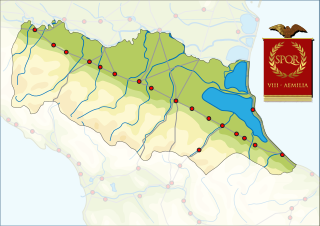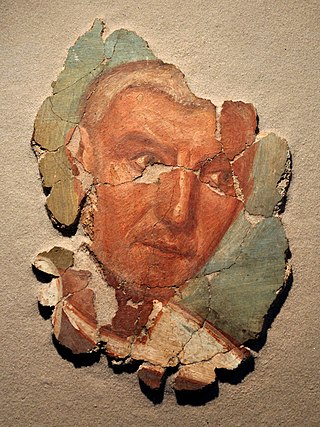
Gaul was a region of Western Europe first clearly described by the Romans, encompassing present-day France, Belgium, Luxembourg, and parts of Switzerland, the Netherlands, Germany, and Northern Italy. It covered an area of 494,000 km2 (191,000 sq mi). According to Julius Caesar, who took control of the region on behalf of the Roman Republic, Gaul was divided into three parts: Gallia Celtica, Belgica, and Aquitania.

In Gallo-Roman religion, Rosmerta was a goddess of fertility and abundance, her attributes being those of plenty such as the cornucopia. Rosmerta is attested by statues and by inscriptions. In Gaul she was often depicted with the Roman god Mercury as her consort, but is sometimes found independently.

Cisalpine Gaul was the name given, especially during the 4th and 3rd centuries BC, to a region of land inhabited by Celts (Gauls), corresponding to what is now most of northern Italy.
The Allobroges were a Gallic people dwelling in a large territory between the Rhône river and the Alps during the Iron Age and the Roman period.

Mediolanum, the ancient city where Milan now stands, was originally an Insubrian city, but afterwards became an important Roman city in Northern Italy.

Gallia Narbonensis was a Roman province located in what is now Occitania and Provence, in Southern France. It was also known as Provincia Nostra, because it was the first Roman province north of the Alps, and as Gallia Transalpina, distinguishing it from Cisalpine Gaul in Northern Italy. It became a Roman province in the late 2nd century BC. Gallia Narbonensis was bordered by the Pyrenees Mountains on the west, the Cévennes to the north, the Alps on the east, and the Gulf of Lion on the south; the province included the majority of the Rhone catchment. The western region of Gallia Narbonensis was known as Septimania. The province was a valuable part of the Roman Empire, owing to the Greek colony and later Roman Civitas of Massalia, its location between the Spanish provinces and Rome, and its financial output.

The Lingones were a Gallic tribe of the Iron Age and Roman periods. They dwelled in the region surrounding the present-day city of Langres, between the provinces of Gallia Lugdunensis and Gallia Belgica.

Lepontic is an ancient Alpine Celtic language that was spoken in parts of Rhaetia and Cisalpine Gaul between 550 and 100 BC. Lepontic is attested in inscriptions found in an area centered on Lugano, Switzerland, and including the Lake Como and Lake Maggiore areas of Italy. Being a Celtic language, its name could derive from Proto-Celtic *leikwontio-.

The Tungri were a tribe, or group of tribes, who lived in the Belgic part of Gaul, during the times of the Roman Empire. Within the Roman Empire, their territory was called the Civitas Tungrorum. They were described by Tacitus as being the same people who were first called "Germani" (Germanic), meaning that all other tribes who were later referred to this way, including those in Germania east of the river Rhine, were named after them. More specifically, Tacitus was thereby equating the Tungri with the "Germani Cisrhenani" described generations earlier by Julius Caesar. Their name is the source of several place names in Belgium, Germany and the Netherlands, including Tongeren, which was the capital of their Roman era province, the civitas Tungrorum, and also places such as Tongerlo Abbey, and Tongelre.

The Via Aemilia was a trunk Roman road in the north Italian plain, running from Ariminum (Rimini), on the Adriatic coast, to Placentia (Piacenza) on the River Padus (Po). It was completed in 187 BC. The Via Aemilia connected at Rimini with the Via Flaminia, which had been completed 33 years earlier, to Rome.

Roman Gaul refers to Gaul under provincial rule in the Roman Empire from the 1st century BC to the 5th century AD.
The Vocontii were a Gallic people dwelling on the western foothills of the Alps during the Iron Age and the Roman period.
Cisalpine is an adjective referring to the Italian side of the Alps. If may refer to:
The Celtic Cisalpine Gaulish inscriptions are frequently combined with the Lepontic inscriptions under the term Celtic language remains in northern Italy. While it is possible that the Lepontii were autochthonous to Northern Italy since the end of the 2nd millennium BC, it is known from ancient sources that the Gauls invaded the regions north of the river Po in several waves since the 5th century BC. They apparently took over the art of writing from the Lepontii, including some of the orthographic peculiarities. There are 20 Cisalpine Gaulish inscriptions, five of them longer than just one or two words. The inscriptions stem largely from the area south of the Lepontians.

The Cenomani, was an ancient tribe of the Cisalpine Gauls, who occupied the tract north of the Padus, between the Insubres on the west and the Veneti on the east. Their territory appears to have extended from the river Addua to the Athesis.

Gallo-Roman culture was a consequence of the Romanization of Gauls under the rule of the Roman Empire. It was characterized by the Gaulish adoption or adaptation of Roman culture, language, morals and way of life in a uniquely Gaulish context. The well-studied meld of cultures in Gaul gives historians a model against which to compare and contrast parallel developments of Romanization in other less-studied Roman provinces.

The Gauls were a group of Celtic peoples of mainland Europe in the Iron Age and the Roman period. Their homeland was known as Gaul (Gallia). They spoke Gaulish, a continental Celtic language.
Gaulish is an extinct Celtic language spoken in parts of Continental Europe before and during the period of the Roman Empire. In the narrow sense, Gaulish was the language of the Celts of Gaul. In a wider sense, it also comprises varieties of Celtic that were spoken across much of central Europe ("Noric"), parts of the Balkans, and Anatolia ("Galatian"), which are thought to have been closely related. The more divergent Lepontic of Northern Italy has also sometimes been subsumed under Gaulish.

Over the course of nearly four centuries, the Roman Republic fought a series of wars against various Celtic tribes, whom they collectively described as Galli, or Gauls. Among the principal Gallic peoples described as antagonists by Greek and Roman writers were the Senones, Insubres, Boii, and Gaesatae.












